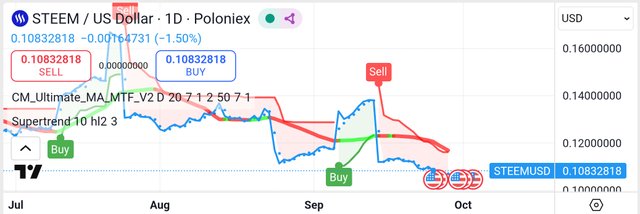1 STEEM = $0.12 USD - How it's designed for hosting social media and blogging platforms?
The Steem blockchain is a decentralized, open-source protocol uniquely designed for hosting social media and blogging platforms. From a technical analysis perspective, its native token, STEEM, has recently exhibited potentially negative momentum, as suggested by the Ultimate Moving Average indicator, which has currently transitioned to a bearish trend, signaling a downward shift in its underlying price direction.
The Steem network achieves high throughput and negligible transaction fees by employing the Delegated Proof-of-Stake (DPoS) consensus mechanism, where token holders elect "witnesses" to validate transactions. Concurrently, technical market indicators for STEEM show a defensive posture; the SuperTrend indicator has recently switched to issuing a sell signal, reinforcing the notion of a prevailing bearish trend that traders may monitor.
Steem's most distinctive and innovative feature is its rewards system, which directly ties financial compensation to user engagement, a model sometimes referred to as "Proof-of-Brain." Economically, the blockchain allocates a significant portion—approximately 75% of the annual inflation—to a rewards pool designed to incentivize and compensate content creators and curators for the value they add to the ecosystem.
About Steem Blockchain (STEEM)
The Steem blockchain is a decentralized, open-source protocol engineered specifically to host social media and blogging platforms, fundamentally altering the traditional economic model of content monetization. Its primary objective is to reward users directly with its native cryptocurrency, STEEM, for contributing value through content creation and curation, a mechanism often referred to as "Proof-of-Brain" (PoB).
Core Technological Architecture
The Steem blockchain utilizes a Delegated Proof-of-Stake (DPoS) consensus mechanism. This highly efficient system is crucial for enabling the high throughput and low-latency required for social media applications. Instead of resource-intensive mining, STEEM token holders elect a set of "witnesses" who are responsible for producing and validating blocks. This architecture allows the network to achieve a claimed block time of approximately 3 seconds with essentially zero transaction fees for users, supporting scalable social interactions that are prohibitive on slower, fee-based blockchains.
Unique Economic Model and Assets
Steem's unique structure is underpinned by a trifecta of native digital assets:
- STEEM: The primary liquid token used for trading and converting into other assets.
- Steem Power (SP): A non-liquid vesting token acquired by "powering up" STEEM. SP grants holders increased voting influence over the daily content rewards and is rewarded to witnesses. The more SP a user holds, the more weight their upvote carries in determining content payouts. SP is essential for long-term stake in the network.
- Steem Dollars (SBD): A soft-pegged semi-stablecoin intended to track the value of one US dollar, though its price can fluctuate. SBD is issued alongside SP as rewards for content creators and curators.
The rewards system is its most distinctive feature: unlike conventional blockchains where 100% of newly minted tokens go to validators, Steem allocates approximately 75% of the annual inflation to a rewards pool that compensates content creators and curators based on community upvotes. Only about 10% is allocated to the DPoS witnesses, with the rest going to SP holders. This direct incentivization model aims to drive network growth and quality content.
Application Layer Features
The protocol incorporates built-in primitives for social media, such as escrow services, a reputation system, and planned mechanisms to facilitate Smart Media Tokens (SMTs), which are custom tokens that projects can launch on the Steem blockchain to monetize content and user engagement on their own decentralized applications (dApps). Its design as a publicly accessible, immutable database for plain text content makes it an foundational layer for dApps like the flagship platform, Steemit.
Disclaimer: I’m not a financial advisor—the information I share is for education only, not investment advice, and any decisions you make are at your own risk.
Assisted by https://gemini.google.com/.
See also:
- Reversteem: merges the strategic thrills of classic Reversi with the decentralized power of Steem blockchain, letting you duel friends through blockchain-recorded games
- @steem.amal: Charity At Your Fingertips
- Maximize curation rewards: follow our trail! Maksimalkan reward kurasi: ikuti trail kami! トレイルをフォローし、キユレーション報酬を最大化!
- Pi Network - Crypto Pertama Yang Dapat Ditambang Di Ponsel
- Piネットワーク — スマートフォンでマイニングできる最初の暗号通貨

Upvoted! Thank you for supporting witness @jswit.